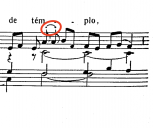Question about notation in Portier's accompaniment for the Liber Cantualis
-
Abbé Portier wrote the accompaniment, used perhaps by many here (or at least you know about it), for the Liber Cantualis published by Solesmes.
I was wondering if there was something going on at the bistropha, circled (in red or else in grey…). I can see the tie, but at the end of the tie, it looks like staccato markings, and this occurs every time (so at "egredientem", here at "templo", "aqua", and at "salvi") which suggests that it's meaningful, it's just that I haven't a clue why it should be staccato versus "normal" or what else it could indicate. (I know that Jeff Ostrowski isn't the biggest fan of Portier's choices, and the keys are a little low sometimes, but I mostly like them, which is why I'm taking time to study his transcription of the melodies.) -
I believe these indicate repercussions expected (a la Dom Cardine) in the voices of the singers for these notes, leaving it up to the organist to do whatever. I usually sing chant with the choir while playing so I will repercuss these notes with the choir while accompanying on the organ, without any staccato. Not everyone agrees that these notes should have a repercussion, and moreover, even if they do, it is not often done since it takes some training for the choir to be in sync.
I think Portier's are good for most non-professional singers today who often have a poor voice range. Accompaniments such as by Potiron are often too high, but then, European organs are often tuned at a lower pitch than they are in North America. -
Aha. That checks out, and right to everything you say about repercussing or not (we don't in my schola, but I know of people and monastic families who don't think, as Mocquereau did, that it is perhaps too much of a hassle).
Right, I don't think that they're universally too low, but the Ave Maris Stella in Sabbato as found in this book is pretty low! I know that D minor or C, if you have no need of Si flat is the typical key if the dominant is A, for mode I chants, but Fontgombault uses 4 flats (A major or really F minor). :)
We use Potiron for Vespers and Benediction, in part so as to not reinvent the wheel, in part because I'm fond of that style as well. He chose A for the dominant at Vespers.Thanked by 1tomjaw
Welcome to the MusicaSacra Forum!
To participate in the discussions on Catholic church music, sign in or register as a forum member, The forum is a project of the Church Music Association of America.
Categories
- All Discussions21,124
- General Music Discussion7,602
- Job Openings1,309
- Management of Music Programs833
- Choral Matters519
- Church Documents and Rubrics504
- CMAA Notes291
- Events651
- For Newcomers: Read First23
- Sacred Polyphony529
- Hymnody821
- Gregorian Chant: General2,583
- ↳ Graduale Romanum and Liber Usualis354
- ↳ Graduale Simplex55
- ↳ Semiology57
- Vernacular Plainsong671
- Anglican Use and Anglican Chant66
- Organ, Other Instruments and Repertoire414
- New Composition/Works in Progress1,208
- Recordings222
- Music for Hispanic Ministry151
- Music Education: Children205
- Music Education: General214
- News Items242
- Positions Wanted58
- General Discussion: Catholicism723
- Amusements171
- General Discussion1,001
- Opinions113

